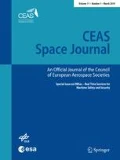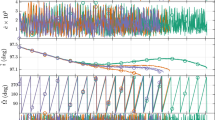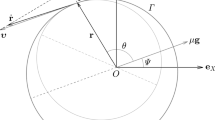Abstract
The algorithms used in the construction of a semi-analytical propagator for the long-term propagation of highly elliptical orbits (HEO) are described. The software propagates mean elements and include the main gravitational and non-gravitational effects that may affect common HEO orbits, as, for instance, geostationary transfer orbits or Molniya orbits. Comparisons with numerical integration show that it provides good results even in extreme orbital configurations, as the case of SymbolX.







Similar content being viewed by others
Notes
A partial list of orbit propagators can be found in http://faculty.nps.edu/bneta/papers/list.pdf, accessed September 29, 2016.
References
Armellin, R., San-Juan, J.F., Lara, M.: End-of-life disposal of high elliptical orbit missions: the case of INTEGRAL. In: Advances in Space Research. Advances in Asteroid and Space Debris Science and Technology—Part 1, vol. 56(3), pp. 479–493 (2015). doi:10.1016/j.asr.2015.03.020
Breakwell, J.V., Vagners, J.: On error bounds and initialization in satellite orbit theories. Celest. Mech. 2, 253–264 (1970). doi:10.1007/BF01229499
Chapront, J., Francou, G.: The lunar theory ELP revisited. Introduction of new planetary perturbations. Astron. Astrophys. 404, 735–742 (2003). doi:10.1051/0004-6361:20030529
Chapront-Touze, M., Chapront, J.: ELP 2000–85—a semi-analytical lunar ephemeris adequate for historical times. Astron. Astrophys. 190, 342–352 (1988)
Coffey, S.L., Neal, H.L., Segerman, A.M., Travisano, J.J.: An analytic orbit propagation program for satellite catalog maintenance. In: Alfriend, K.T., Ross, I.M., Misra, A.K., Peters, C.F. (eds.) AAS/AIAA Astrodynamics Conference 1995, Advances in the Astronautical Sciences, vol. 90, pp. 1869–1892. American Astronautical Society, Univelt Inc, USA (1996)
Danielson, D.A., Neta, B., Early, L.W.: Semianalytic satellite theory (SST): mathematical algorithms. Technical report NPS-MA-94-001, Naval Postgraduate School, Naval Postgraduate School, Monterey, CA, Department of Mathematics (1994)
Deprit, A.: Canonical transformations depending on a small parameter. Celes. Mech. 1(1), 12–30 (1969). doi:10.1007/BF01230629
Deprit, A.: The elimination of the parallax in satellite theory. Celes. Mech. 24(2), 111–153 (1981). doi:10.1007/BF01229192
Efroimsky, M.: Gauge freedom in orbital mechanics. Ann. N. Y. Acad. Sci. 1065, 346–374 (2005). doi:10.1196/annals.1370.016
Exertier, A.: Orbitographie des satellites artificiels sur de grandes periodes de temps. Possibilites d’applications. Ph.D. thesis. Observatoire de Paris, Paris (1988)
Garfinkel, B.: On the motion of a satellite of an oblate planet. Astron. J. 63(1257), 88–96 (1958). doi:10.1086/107697
Golikov, A.R.: THEONA—a numerical-analytical theory of motion of artificial satellites of celestial bodies. Cosmic Res. 50(6), 449–458 (2012). doi:10.1134/S0010952512060020
Harris, I., Priester, W.: Time-dependent structure of the upper atmosphere. J. Atmos. Sci. 19, 286–301 (1962). doi:10.1175/1520-0469(1962)019<0286:TDSOTU>2.0.CO;2
Hautesserres, D.: Extrapolation long terme de l’orbite du satellite SimbolX par la methode de Gragg-Bulirsch-Stoer (GBS). Technical report DCT/SB/OR/2009-2474, Centre National d’Études Spatiales, 18, avenue Edouard Belin, 31401 Toulouse Cedex 9, France (2009)
Hautesserres, D., Lara, M.: Intermediary LEO propagation including higher order zonal harmonics. Celes. Mech. Dyn. Astron. 127(4) 505–526 (2017). doi:10.1007/s10569-016-9736-6
Hoots, F.R., Roehrich, R.L.: Models for propagation of the NORAD element sets. Project SPACETRACK, Report 3, U.S. Air Force Aerospace Defense Command, Colorado Springs, CO (1980)
Kaufman, B.: First order semianalytic satellite theory with recovery of the short period terms due to third body and zonal perturbations. Acta Astronaut. 8(5–6), 611–623 (1981). doi:10.1016/0094-5765(81)90108-9
Kaula, W.M.: Theory of satellite geodesy. Applications of satellites to geodesy. Blaisdell, Waltham (1966)
Kozai, Y.: Effects of solar radiation pressure on the motion of an artificial satellite. SAO Spec. Rep. 56, 25–34 (1961)
Kozai, Y.: Second-order solution of artificial satellite theory without air drag. Astron. J. 67(7), 446–461 (1962)
Lara, M.: Simplified equations for computing science orbits around planetary satellites. J. Guid. Control Dyn. 31(1), 172–181 (2008). doi:10.2514/1.31107
Lara, M., San-Juan, J., Hautesserres, D.: Semi-analytical propagator of high eccentricity orbits. Technical report R-S15/BS-0005-024, Centre National d’Études Spatiales, 18, avenue Edouard Belin, 31401 Toulouse Cedex 9, France (2016)
Lara, M., San-Juan, J.F., Folcik, Z.J., Cefola, P.: Deep resonant GPS-dynamics due to the geopotential. J. Astronaut. Sci. 58(4), 661–676 (2011). doi:10.1007/BF03321536
Lara, M., San-Juan, J.F., López, L.M., Cefola, P.J.: On the third-body perturbations of high-altitude orbits. Celes. Mech. Dyn. Astron. 113, 435–452 (2012). doi:10.1007/s10569-012-9433-z
Lara, M., San-Juan, J.F., López-Ochoa, L.M.: Delaunay variables approach to the elimination of the perigee in artificial satellite theory. Celest. Mech. Dyn. Astron. 120(1), 39–56 (2014). doi:10.1007/s10569-014-9559-2
Lara, M., San-Juan, J.F., López-Ochoa, L.M.: Proper averaging via parallax elimination (AAS 13–722). In: Astrodynamics 2013. Advances in the Astronautical Sciences, vol. 150, pp. 315–331. American Astronautical Society, Univelt Inc, USA (2014)
Lara, M.: Vilhena de Moraes, R., Sanchez, D.M., Prado, A.F.B.A.: Efficient computation of short-period analytical corrections due to third-body effects (AAS 15-295). In; Proceedings of the 25th AAS/AIAA Space Flight Mechanics Meeting. Williamsburg, VA, January 11–15, 2015, Advances in the Astronautical Sciences, vol. 155, pp. 437–455. American Astronautical Society, Univelt Inc, USA (2015)
Long, A.C., Cappellari, J.O., Velez, C.E., Fluchs, A.J.: Mathematical theory of the Goddard Trajectory Determination System. Technical report FDD/552-89/001, National Aeronautics and Space Administration, Goddard Space Flight Center, Greenbelt, MD (1989)
McClain, W.D.: A Recursively Formulated First-Order Semianalytic Artificial Satellite Theory Based on the Generalized Method of Averaging, Volume 1: The Generalized Method of Averaging Applied to the Artificial Satellite Problem, 2nd edn. NASA CR-156782, NASA, Greenbelt (1977)
Meeus, J.: Mathematical Astronomy Morsels. Willmann-Bell, Richmond (1997)
Meeus, J.: Astronomical Algorithms, 2nd edn. Willmann-Bell, Richmond (1998)
Montenbruck, O., Gill, E.: Satellite Orbits. Models, Methods and Applications. Physics and Astronomy. Springer, Berlin (2001)
San-Juan, J.F., Lara, M., Ferrer, S.: Phase space structure around oblate planetary satellites. J. Guid. Control Dyn. 29, 113–120 (2006). doi:10.2514/1.13385
Sterne, T.E.: The gravitational orbit of a satellite of an oblate planet. Astron. J. 63, 28–40 (1958). doi:10.1086/107673
Vallado, D.A.: Fundamentals of Astrodynamics and Applications, 2nd edn. Microcosm, Dordrecht (2001)
Acknowledgements
This work is partially supported by the Spanish State Research Agency and the European Regional Development Fund (AEI/ERDF, EU) under Projects ESP2013-41634-P (M. L.), and ESP2014-57071-R and ESP2016-76585-R (M. L. and J. F. S.). Funded by CNES contract Ref. DAJ-AR-EO-2015-8181.
Author information
Authors and Affiliations
Corresponding author
Additional information
This paper is based on a presentation at the 6th International Conference on Astrodynamics Tools and Techniques, March 14–17, 2016, Darmstadt, Germany.
Appendices
Appendix A: Some useful partial derivatives in elliptic motion
When dealing with automatic manipulation of literal expressions, it results practical to limit the symbolic algebra to the basic arithmetic operations, to wit, addition, subtraction, multiplication and division—integer powers being a particular case of multiplication. However, square roots and trigonometric functions appear naturally in the formulation of the perturbation in canonical variables. To avoid dealing explicitly with square roots, it is wise to be equipped with a battery of partial derivatives that ease handling and simplifying symbolic expressions.
Since our perturbation approach relies on the use of Delaunay and polar-nodal canonical variables, the partial derivatives of the classical Keplerian variables \((a,e,I,\Omega ,\omega ,M)\), standing for semi-major axis, eccentricity, inclination, right ascension of the ascending node, argument of the periapsis and mean anomaly, respectively, as well as the usual functions of the Keplerian variables
-
the mean motion \(n=\sqrt{\mu /a^3}\),
-
the parameter (or semilatus rectum) \(p=a\,(1-e^2)\),
-
the eccentricity function \(\eta =\sqrt{1-e^2}\),
-
the cosine of the inclination \(c=\cos {I}\),
-
the sine of the inclination \(s=\sqrt{1-c^2}\),
-
the eccentric anomaly u, given by \(M=u-e\sin {u}\),
-
the true anomaly f, given by \((1-e)\tan \frac{1}{2}f=\eta \tan \frac{1}{2}u\),
-
the radial distance \(r=a\,(1-e\cos {u})=p/(1+e\cos {f})\),
-
the radial velocity \(R=a\,n\,(a/r)\,e\sin {u}=a\,n\,(e/\eta )\sin {f}\),
-
the argument of the latitude \(\theta =f+\omega\),
-
the projections of the eccentricity vector in the orbital frame: \(k=e\cos {f}=-1+p/r\), and \(q=e\sin {f}=R\,\eta /(n\,a)\),
are provided both in the Delaunay chart \((\ell ,g,h,L,G,H)\) and in the polar-nodal chart \((r,\theta ,\nu ,R,\Theta ,N)\).
We found convenient to express all the partial derivatives by means of the Keplerian functions:
from whose definition it is obtained
Recall also that, from the ellipse geometry, the following relations apply, cf. Eq. (34),
Finally, it is worth to mention that the use of logarithmic derivatives is helpful in finding the differentials that eased the computation of the partial derivatives. Note that only non-vanishing derivatives are presented.
1.1 A.1: With respect to Delaunay variables
1.1.1 A.1.1: Orbital elements and related functions
-
Semi-major axis a:
$$\begin{aligned} \frac{\mathrm {d}a}{\mathrm {d}L}=2\frac{L}{\mu } = 2\frac{\eta ^2}{n\,p} \end{aligned}$$(56) -
Mean motion n:
$$\begin{aligned} \frac{\mathrm {d}n}{\mathrm {d}L} = -3\frac{\eta ^4}{p^2} \end{aligned}$$(57) -
Parameter p:
$$\begin{aligned} \frac{\mathrm {d}p}{\mathrm {d}G}= 2\frac{G}{\mu } =2\frac{\eta ^3}{n\,p} \end{aligned}$$(58) -
Eccentricity function \(\eta\):
$$\begin{aligned} \frac{\mathrm {d}\eta }{\mathrm {d}L}= & \eta \left( -\frac{1}{L}\right) = -\frac{\eta ^5}{n\,p^2} \end{aligned}$$(59)$$\begin{aligned} \frac{\mathrm {d}\eta }{\mathrm {d}G}= & \eta \left( \frac{1}{G}\right) = \frac{\eta ^4}{n\,p^2} \end{aligned}$$(60) -
Eccentricity e:
$$\begin{aligned} \frac{\mathrm {d}e}{\mathrm {d}L}= & \frac{\eta ^2}{e}\,\frac{1}{L} = \frac{\eta ^6}{e\,n\,p^2} \end{aligned}$$(61)$$\begin{aligned} \frac{\mathrm {d}e}{\mathrm {d}G}= & -\frac{\eta ^2}{e}\,\frac{1}{G} =-\frac{\eta ^5}{e\,n\,p^2} \end{aligned}$$(62) -
Cosine of inclination c:
$$\begin{aligned} \frac{\mathrm {d}c}{\mathrm {d}G} = -\frac{c}{G}=-c\,\frac{\eta ^3}{n\,p^2} \end{aligned}$$(63)$$\begin{aligned} \frac{\mathrm {d}c}{\mathrm {d}H} = \frac{c}{H}=\frac{1}{G}=\frac{\eta ^3}{n\,p^2} \end{aligned}$$(64) -
Sine of inclination s:
$$\begin{aligned} \frac{\mathrm {d}s}{\mathrm {d}G} = \frac{c^2}{s}\,\frac{\eta ^3}{n\,p^2} \end{aligned}$$(65)$$\begin{aligned} \frac{\mathrm {d}s}{\mathrm {d}H} = -\frac{c}{s}\,\frac{\eta ^3}{n\,p^2} \end{aligned}$$(66) -
Eccentric anomaly u:
$$\begin{aligned} \frac{\mathrm {d}u}{\mathrm {d}\ell } = \frac{p}{r\,\eta ^2}=\frac{1+k}{\eta ^2} \end{aligned}$$(67)$$\begin{aligned} \frac{\mathrm {d}u}{\mathrm {d}L} = \frac{R\,\eta ^8}{e^2\,n^2\,p^3}= \frac{q\,\eta ^5}{e^2\,n\,p^2} \end{aligned}$$(68)$$\begin{aligned} \frac{\mathrm {d}u}{\mathrm {d}G} = -\frac{R\,\eta ^7}{e^2\,n^2\,p^3}=-\frac{q\,\eta ^4}{e^2\,n\,p^2} \end{aligned}$$(69)
1.1.2 A.1.2: Polar-nodal variables and related functions
-
Radial distance r:
$$\begin{aligned} \frac{\mathrm {d}r}{\mathrm {d}\ell } = \frac{R}{n}=\frac{p\,q}{\eta ^3} \end{aligned}$$(70)$$\begin{aligned} \frac{\mathrm {d}r}{\mathrm {d}L} = \frac{\eta ^4}{e^2\,n}\left( \frac{2 e^2 r}{p^2}+\frac{1}{p}-\frac{1}{r}\right) =\frac{\eta ^4}{n\,p}\left( \frac{2}{1+k}-\frac{k}{e^2}\right) \end{aligned}$$(71)$$\begin{aligned} \frac{\mathrm {d}r}{\mathrm {d}G} = \frac{\eta ^3}{e^2\,n}\left( \frac{1}{r}-\frac{1}{p}\right) =\frac{\eta ^3\,k}{e^2\,n\,p} \end{aligned}$$(72) -
Radial velocity R:
$$\begin{aligned} \frac{\mathrm {d}R}{\mathrm {d}\ell } = \frac{p\,n}{\eta ^6}\frac{p^2}{r^2}\left( \frac{p}{r}-1\right) =\frac{p\,n}{\eta ^6}\,k\,(1+k)^2 \end{aligned}$$(73)$$\begin{aligned} \frac{\mathrm {d}R}{\mathrm {d}L} = \eta ^4\,\frac{R}{n\,r^2}\left( \frac{1}{e^2}-\frac{r^2}{p^2}\right) =\eta \,\frac{q}{p}\left[ \frac{(1+k)^2}{e^2}-1\right] \end{aligned}$$(74)$$\begin{aligned} \frac{\mathrm {d}R}{\mathrm {d}G} = -\frac{\eta ^3}{e^2}\,\frac{R}{n\,r^2}=-\frac{(1+k)^2}{e^2}\,\frac{q}{p} \end{aligned}$$(75) -
True anomaly f:
$$\begin{aligned} \frac{\mathrm {d}f}{\mathrm {d}\ell } = \frac{\eta \,r}{a\,n\,(p-r)}\,\frac{\mathrm {d}R}{\mathrm {d}\ell }=\frac{p^2}{r^2\,\eta ^3}=\frac{(1+k)^2}{\eta ^3} \end{aligned}$$(76)$$\begin{aligned} \frac{\mathrm {d}f}{\mathrm {d}L} = \frac{R\,\eta ^7}{e^2\,n^2\,p^2}\left( \frac{1}{p}+\frac{1}{r}\right) =\frac{q\,\eta ^4}{e^2\,n\,p^2}\,(2+k)\end{aligned}$$(77)$$\begin{aligned} \frac{\mathrm {d}f}{\mathrm {d}G} = -\frac{R\,\eta ^6}{e^2\,n^2\,p^2}\left( \frac{1}{p}+\frac{1}{r}\right) =-\frac{q\,\eta ^3}{e^2\,n\,p^2}\,(2+k) \end{aligned}$$(78) -
Argument of the latitude \(\theta\):
$$\begin{aligned} \frac{\mathrm {d}\theta }{\mathrm {d}\ell } = \frac{\mathrm {d}f}{\mathrm {d}\ell }\end{aligned}$$(79)$$\begin{aligned} \frac{\mathrm {d}\theta }{\mathrm {d}g} = 1\end{aligned}$$(80)$$\begin{aligned} \frac{\mathrm {d}\theta }{\mathrm {d}L} = \frac{\mathrm {d}f}{\mathrm {d}L}\end{aligned}$$(81)$$\begin{aligned} \frac{\mathrm {d}\theta }{\mathrm {d}G} = \frac{\mathrm {d}f}{\mathrm {d}G} \end{aligned}$$(82) -
Modulus of the angular momentum \(\Theta\):
$$\begin{aligned} \frac{\mathrm {d}\Theta }{\mathrm {d}G} = 1 \end{aligned}$$(83) -
Argument of the node \(\nu\):
$$\begin{aligned} \frac{\mathrm {d}\nu }{\mathrm {d}h} = 1 \end{aligned}$$(84) -
Polar component of the angular momentum N:
$$\begin{aligned} \frac{\mathrm {d}N}{\mathrm {d}H} = 1 \end{aligned}$$(85) -
Eccentricity vector k:
$$\begin{aligned} \frac{\mathrm {d}k}{\mathrm {d}\ell } = -\frac{p\,R}{r^2\,n}=-\frac{q}{\eta ^3}(1+k)^2 \end{aligned}$$(86)$$\begin{aligned} \frac{\mathrm {d}k}{\mathrm {d}L} = \frac{\eta ^4}{n\,r^2}\left( \frac{k}{e^2}-\frac{2}{k+1}\right) \end{aligned}$$(87)$$\begin{aligned} \frac{\mathrm {d}k}{\mathrm {d}G} = -\frac{\eta ^3}{n\,r^2}\left( \frac{k}{e^2}-\frac{2}{k+1}\right) \end{aligned}$$(88) -
Eccentricity vector q:
$$\begin{aligned} \frac{\mathrm {d}q}{\mathrm {d}\ell } = \frac{1}{\eta ^3}\frac{p^2}{r^2}\left( \frac{p}{r}-1\right) =\frac{k}{\eta ^3}\frac{p^2}{r^2}=\frac{k}{\eta ^3}\,(1+k)^2 \end{aligned}$$(89)$$\begin{aligned} \frac{\mathrm {d}q}{\mathrm {d}L} = \frac{q\,\eta ^4}{n\,r^2}\left( \frac{1}{e^2}-\frac{r^2}{p^2}\right) =\frac{q\,\eta ^4}{n\,p^2}\left[ \frac{(1+k)^2}{e^2}-1\right] \end{aligned}$$(90)$$\begin{aligned} \frac{\mathrm {d}q}{\mathrm {d}G} = -\frac{q\,\eta ^3}{n\,r^2}\left( \frac{1}{e^2}-\frac{r^2}{p^2}\right) =-\frac{q\,\eta ^3}{n\,p^2}\left[ \frac{(1+k)^2}{e^2}-1\right] \end{aligned}$$(91)
1.2 A.2: With respect to polar-nodal variables
1.2.1 A.2.1: Delaunay variables
-
Delaunay action L:
$$\begin{aligned} \frac{\mathrm {d}L}{\mathrm {d}r} = -\frac{\Theta }{p}\,\frac{k}{\eta ^3}\,(1+k)^2 =-np\,\frac{k}{\eta ^6}\,(1+k)^2\end{aligned}$$(92)$$\begin{aligned} \frac{\mathrm {d}L}{\mathrm {d}R} = \frac{\Theta }{n}\,\frac{q}{p} = p\frac{q}{\eta ^3} \end{aligned}$$(93)$$\begin{aligned} \frac{\mathrm {d}L}{\mathrm {d}\Theta } = \frac{p^2}{\eta ^3\,r^2} = \frac{(1+k)^2}{\eta ^3} \end{aligned}$$(94) -
Modulus of the angular momentum \(\Theta\):
$$\begin{aligned} \frac{\mathrm {d}G}{\mathrm {d}\Theta } = 1 \end{aligned}$$(95) -
Polar component of the angular momentum N:
$$\begin{aligned} \frac{\mathrm {d}H}{\mathrm {d}N} = 1 \end{aligned}$$(96) -
Mean anomaly \(\ell\):
$$\begin{aligned} \frac{\mathrm {d}\ell }{\mathrm {d}r} = \eta \,\frac{q}{r}\left( \frac{1+k}{e^2}-\frac{1}{1+k}\right) \end{aligned}$$(97)$$\begin{aligned} \frac{\mathrm {d}\ell }{\mathrm {d}R} = \eta \,\frac{q}{R}\left( \frac{k}{e^2}-\frac{2}{1+k}\right) \end{aligned}$$(98)$$\begin{aligned} \frac{\mathrm {d}\ell }{\mathrm {d}\Theta }= -\eta \,\frac{q}{\Theta }\,\frac{2+k}{e^2} \end{aligned}$$(99) -
Argument of the perigee g:
$$\begin{aligned} \frac{\mathrm {d}g}{\mathrm {d}r}= -\frac{q}{r}\,\frac{1+k}{e^2} \end{aligned}$$(100)$$\begin{aligned} \frac{\mathrm {d}g}{\mathrm {d}\theta } = 1 \end{aligned}$$(101)$$\begin{aligned} \frac{\mathrm {d}g}{\mathrm {d}R} = -\frac{q}{R}\,\frac{k}{e^2} \end{aligned}$$(102)$$\begin{aligned} \frac{\mathrm {d}g}{\mathrm {d}\Theta } = \frac{q}{\Theta }\,\frac{2+k}{e^2} \end{aligned}$$(103) -
Right ascension of the ascending node h:
$$\begin{aligned} \frac{\mathrm {d}h}{\mathrm {d}\nu } = 1 \end{aligned}$$(104)
1.2.2 A.2.2: Orbital elements and related functions
-
Parameter p:
$$\begin{aligned} \frac{\mathrm {d}p}{\mathrm {d}\Theta } &= 2\frac{p}{\Theta }=2\frac{\eta ^3}{n\,p} \end{aligned}$$(105) -
Eccentricity vector k:
$$\begin{aligned} \frac{\mathrm {d}k}{\mathrm {d}r} = -\frac{p}{r^2}=-\frac{(1+k)^2}{p} \end{aligned}$$(106)$$\begin{aligned} \frac{\mathrm {d}k}{\mathrm {d}\Theta } = \frac{2p}{r\,\Theta }=\frac{2q}{r\,R} =\frac{2(1+k)\,\eta ^3}{n\,p^2} \end{aligned}$$(107) -
Eccentricity vector q:
$$\begin{aligned} \frac{\mathrm {d}q}{\mathrm {d}R} = \frac{q}{R}=\frac{p}{\Theta } =\frac{\eta ^3}{n\,p} \end{aligned}$$(108)$$\begin{aligned} \frac{\mathrm {d}q}{\mathrm {d}\Theta } = \frac{q}{\Theta }=\frac{q^2}{R\,p} =\frac{q\,\eta ^3}{n\,p^2} \end{aligned}$$(109) -
Eccentricity e:
$$\begin{aligned} \frac{\mathrm {d}e}{\mathrm {d}r} = -\frac{k}{e}\,\frac{p}{r^2} =-\frac{k}{e}\,\frac{(1+k)^2}{p} \end{aligned}$$(110)$$\begin{aligned} \frac{\mathrm {d}e}{\mathrm {d}R} = \frac{q^2}{e\,R} =\frac{q\,\eta ^3}{e\,n\,p} \end{aligned}$$(111)$$\begin{aligned} \frac{\mathrm {d}e}{\mathrm {d}\Theta }= \eta ^3\frac{2k(1+k)+q^2}{e\,n\,p^2} \end{aligned}$$(112) -
Eccentricity function \(\eta\):
$$\begin{aligned} \frac{\mathrm {d}\eta }{\mathrm {d}r} = \frac{k}{\eta }\,\frac{p}{r^2} =\frac{k}{\eta }\,\frac{(1+k)^2}{p} \end{aligned}$$(113)$$\begin{aligned} \frac{\mathrm {d}\eta }{\mathrm {d}R} = -\frac{q^2}{\eta \,R} =-\frac{q\,\eta ^2}{n\,p} \end{aligned}$$(114)$$\begin{aligned} \frac{\mathrm {d}\eta }{\mathrm {d}\Theta } = -\eta ^2\frac{2k\,(1+k)+q^2}{n\,p^2} \end{aligned}$$(115) -
Semi-major axis a:
$$\begin{aligned} \frac{\mathrm {d}a}{\mathrm {d}r} = -2\frac{k}{\eta ^4}\,(1+k)^2 \end{aligned}$$(116)$$\begin{aligned} \frac{\mathrm {d}a}{\mathrm {d}R}= 2\frac{p\,q^2}{R\,\eta ^4}=2\frac{q}{n\,\eta } \end{aligned}$$(117)$$\begin{aligned} \frac{\mathrm {d}a}{\mathrm {d}\Theta }= 2\frac{p^3}{\eta ^4\,\Theta \,r^2} =2\frac{(1+k)^2}{n\,p\,\eta } \end{aligned}$$(118) -
Mean motion n:
$$\begin{aligned} \frac{\mathrm {d}n}{\mathrm {d}r} = \frac{3n\,k}{\eta ^2}\,\frac{(1+k)^2}{p} \end{aligned}$$(119)$$\begin{aligned} \frac{\mathrm {d}n}{\mathrm {d}R} = -\frac{3n\,q^2}{R\,\eta ^2}=-3\frac{q\,\eta }{p} \end{aligned}$$(120)$$\begin{aligned} \frac{\mathrm {d}n}{\mathrm {d}\Theta } = -\frac{3n\,p^2}{\eta ^2\,\Theta \,r^2} =-\frac{3\eta }{r^2} \end{aligned}$$(121) -
True anomaly f:
$$\begin{aligned} \frac{\mathrm {d}f}{\mathrm {d}r} = \frac{q}{r}\,\frac{1+k}{e^2} \end{aligned}$$(122)$$\begin{aligned} \frac{\mathrm {d}f}{\mathrm {d}R} = \frac{q}{R}\,\frac{k}{e^2}\end{aligned}$$(123)$$\begin{aligned} \frac{\mathrm {d}f}{\mathrm {d}\Theta } = -\frac{q}{\Theta }\,\frac{2+k}{e^2} \end{aligned}$$(124) -
Eccentric anomaly u:
$$\begin{aligned} \frac{\mathrm {d}u}{\mathrm {d}r} = \frac{\eta }{pq}\left[ 1+\frac{e^2-k}{e^2}\frac{k}{\eta ^2}\,(1+k)\right] (1+k)\end{aligned}$$(125)$$\begin{aligned} \frac{\mathrm {d}u}{\mathrm {d}R} = \frac{a\,n}{R}\left( -\frac{r-a}{r}\,\frac{\mathrm {d}e}{e\mathrm {d}R}-\frac{\mathrm {d}a}{a\mathrm {d}R}\right) \end{aligned}$$(126)$$\begin{aligned} \frac{\mathrm {d}u}{\mathrm {d}\Theta } = \frac{a\,n}{R}\left( -\frac{r-a}{r}\,\frac{\mathrm {d}e}{e\mathrm {d}\Theta }-\frac{\mathrm {d}a}{a\mathrm {d}\Theta }\right) \end{aligned}$$(127) -
Equation of the center \(\phi\):
$$\begin{aligned} \frac{\mathrm {d}\phi }{\mathrm {d}r} = \frac{q}{r}\left( \frac{1+k}{1+\eta }+\frac{\eta }{1+k}\right) \end{aligned}$$(128)$$\begin{aligned} \frac{\mathrm {d}\phi }{\mathrm {d}R} = \frac{q}{R}\left( \frac{k}{1+\eta }+\frac{2\eta }{1+k}\right) \end{aligned}$$(129)$$\begin{aligned} \frac{\mathrm {d}\phi }{\mathrm {d}\Theta } = -\frac{q}{\Theta }\,\frac{2+k}{1+\eta } \end{aligned}$$(130) -
Cosine of inclination c:
$$\begin{aligned} \frac{\mathrm {d}c}{\mathrm {d}\Theta } = -\frac{c}{\Theta } =-\frac{c\,q}{R\,p} = -\frac{c\,\eta ^3}{n\,p^2} \end{aligned}$$(131)$$\begin{aligned} \frac{\mathrm {d}c}{\mathrm {d}N} = \frac{1}{\Theta } =\frac{q}{R\,p} =\frac{\eta ^3}{n\,p^2} \end{aligned}$$(132) -
Sine of inclination s:
$$\begin{aligned} \frac{\mathrm {d}s}{\mathrm {d}\Theta } = \frac{c^2\,\eta ^3}{s\,n\,p^2} \end{aligned}$$(133)$$\begin{aligned} \frac{\mathrm {d}s}{\mathrm {d}N} = -\frac{c\,\eta ^3}{s\,n\,p^2} \end{aligned}$$(134)
Appendix B: Tables of coefficients
The coefficients of the trigonometric series used by HEOSAT are provided in following tables
Rights and permissions
About this article
Cite this article
Lara, M., San-Juan, J.F. & Hautesserres, D. HEOSAT: a mean elements orbit propagator program for highly elliptical orbits. CEAS Space J 10, 3–23 (2018). https://doi.org/10.1007/s12567-017-0152-x
Received:
Revised:
Accepted:
Published:
Issue Date:
DOI: https://doi.org/10.1007/s12567-017-0152-x




